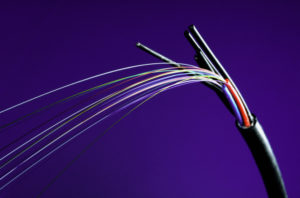
Learn about the components of your fiber optic cables.
Fiber optic cables have many options that benefit all businesses and medical and educational facilities. The appropriate fiber optic cables ensure that your business has faster Internet speeds, broader coverage, better bandwidth, lower cost of ownership, flexibility, versatility, and reliability. Various fiber optic cables exist, such as the LC multimode fiber patch cord and multimode duplex fiber optic patch cable. Data through fiber optics travels as fast as about 70% of the speed of light. Today, we will discuss the three main components of fiber optic cables that allow this to happen.
Fiber Optic Cables: The Core
A fiber optic cable’s core is the tiniest yet most critical component because it carries the light. The core typically consists of glass, although some cores consist of plastic. A core’s makeup also includes a highly pure and transparent silicon dioxide (Si02). During the manufacturing process, the refractive index (the ratio of a light’s velocity or speed in a vacuum’s velocity in a specified medium) raises under controlled conditions through dopants (a substance that produces electrical characteristics in a semiconductor) such as:
- Germania
- Phosphorus Pentoxide
- Alumina
Cladding
The cladding is a cover for the core. It controls light from leaking out of the fiber as it travels along the glass walls. Its refractive index is lower, ensuring that the fiber optic cables work. Manufacturers design the core and cladding together from the same silicone-based material in a permanently fused state whenever glass cladding is used.
Coating
Fiber optic cables are fragile without coating, and every glass fiber comes with coating because they are crucial for protection. The coating is the protective layer of fiber optic cables. It prevents damage to the cladding by absorbing the shocks, nicks, scrapes, and moisture that could damage the cladding.
It’s also important to discuss the difference between a single-mode fiber optic cable and a multimode cable. A single-mode cable is thinner, and it can carry data longer distances. A multimode cable is larger in diameter and can transfer more data, but not as far. Also, light travels at different wavelengths, and data can ride on several different colors of light through a single cable. As a result, it enables more data transfer than a traditional twisted-pair copper cable.
Get in Touch with FiberPlus
FiberPlus has been providing data communication solutions for over 25 years in the Mid-Atlantic Region for a number of different markets. What began as a cable installation company for Local Area Networks has grown into a leading provider of innovative technology solutions improving the way our customers communicate and keeping them secure. Our solutions now include:
- Structured Cabling (Fiberoptic, Copper and Coax for inside and outside plant networks)
- Electronic Security Systems (Access Control & CCTV Solutions)
- Wireless Access Point installations
- Public Safety DAS – Emergency Call Stations
- Audio/Video Services (Intercoms and Display Monitors)
- Support Services
- Specialty Systems
- Design/Build Services
- UL2050 Certifications and installations for Secure Spaces
FiberPlus promises the communities in which we serve that we will continue to expand and evolve as new technology is introduced within the telecommunications industry.